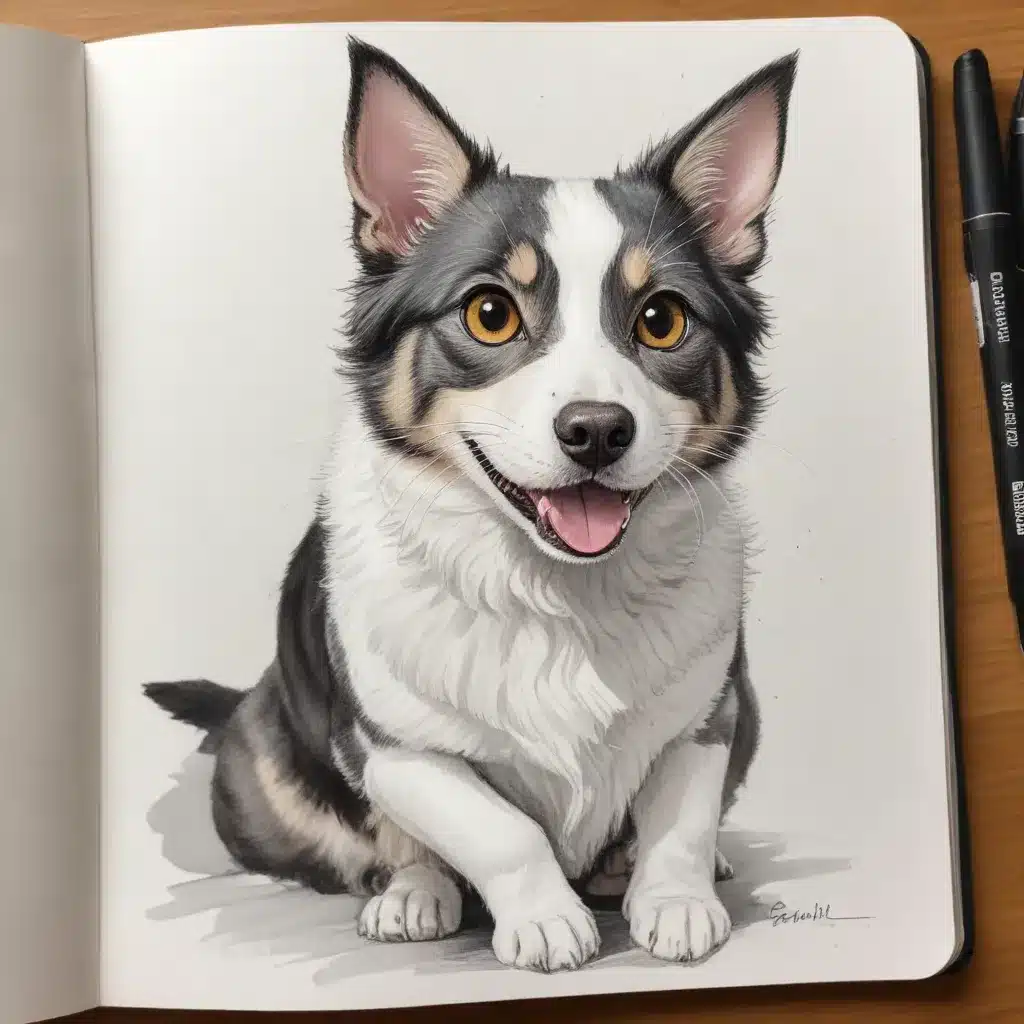
Exploring the Power of Visual Narratives
As a seasoned artist and educator, I’ve seen the profound impact that visual storytelling can have, especially when it comes to capturing the essence of our beloved pets. In this third installment of our “Sketchbook Storytelling” series, we’ll dive deeper into unlocking the narrative potential of your sketchbook, focusing on techniques and approaches that will help you bring the unique personalities of your animal companions to life on the page.
Harnessing Emotions through Expressive Sketching
One of the hallmarks of Tim Burton’s iconic style is his ability to convey complex emotions through the exaggerated features and gestures of his characters. Similarly, when sketching your pets, consider how you can amplify their expressions to evoke a particular mood or sentiment. Pay close attention to the details that make your furry, feathered, or scaly friend unique – the tilt of an ear, the curve of a paw, or the inquisitive tilt of the head. By emphasizing these distinctive elements, you can imbue your sketches with a sense of personality that resonates with the viewer.
As you sketch, experiment with varying the weight of your lines, the intensity of your shading, and the placement of your subject within the frame. These decisions can dramatically shift the emotional tone of your piece, from the playful energy of a wagging tail to the pensive contemplation of a cat’s gaze. Remember, your sketchbook is a safe space to explore and take risks, so don’t be afraid to push the boundaries of realism in pursuit of a more expressive, narrative-driven composition.
Mastering the Art of Visual Storytelling
Just as Michelangelo’s Pietà evokes a powerful narrative through the juxtaposition of Mary’s calm demeanor and the weight of her lifeless son, your pet sketches can also become vehicles for storytelling. Consider how you might capture a moment of connection between you and your animal companion, or a pivotal event in their life, such as the heartbreaking farewell Rae shared with her beloved rat, Sunny.
When composing your sketches, think about the emotional arc you want to convey. Where is the focal point, and how do the surrounding elements guide the viewer’s eye through the scene? Pay attention to the balance of positive and negative space, as well as the interplay of light and shadow, to create a sense of depth and drama. By carefully considering these compositional elements, you can craft visually compelling narratives that resonate with your audience.
Embracing the Unexpected: Incorporating Randomness and Serendipity
Like the “accident in a stable” that defined Caravaggio’s Conversion of St. Paul, your sketchbook can become a space for unexpected discoveries and happy accidents. Embrace the unpredictable nature of the medium, allowing the flow of ink or the textural qualities of your chosen drawing materials to guide your creative process.
As you sketch, be attuned to the serendipitous moments that arise, such as the unintended blots or smudges that could transform into intriguing backgrounds or atmospheric elements. Pay attention to the way the materials interact with one another, and let these discoveries inform the direction of your composition. By staying open to the unexpected, you may find that your sketchbook becomes a wellspring of creative inspiration, leading you down unexpected narrative paths.
Cultivating a Sense of Authenticity through Personal Experiences
Just as the author found solace in the humble, handcrafted offerings of the old woman on the streets of Rome, your sketchbook can become a space to explore your own personal experiences and emotional landscapes. Draw from the moments that have profoundly impacted you, whether it’s the joyful reunion with a beloved pet after a long separation or the bittersweet farewell of a furry companion.
By infusing your sketches with the authenticity of your own lived experiences, you can imbue your work with a sense of emotional resonance that transcends the purely technical aspects of your craft. Allow your sketchbook to become a repository for your memories, fears, and hopes, and let these personal narratives guide the development of your visual storytelling.
Embracing the Power of Reproductions and Copies
As the author muses on the cultural value and significance of the Milwaukee Pietà, it’s important to consider the role that reproductions and copies can play in the dissemination and appreciation of artistic works. In the same way that Michelangelo’s sculptures were replicated and shared during the Renaissance, your pet sketches can also find new life through reproduction.
Whether it’s creating limited-edition prints, digital reproductions, or even sculpting three-dimensional interpretations of your animal subjects, these copies can help to bring your visual narratives to a wider audience. While the “aura” of the original may be lost, these reproductions can still serve as powerful vehicles for storytelling, allowing viewers to engage with your work in new and meaningful ways.
Moreover, as the author notes, the act of copying and recreating can also be a valuable part of the creative process, helping artists to deepen their understanding of their subject matter and refine their technical skills. Embrace the act of reproduction as a means of exploration and discovery, and consider how these copies can contribute to the ongoing dialogue surrounding your artistic vision.
Conclusion: Unleashing the Transformative Power of Sketchbook Storytelling
Through the exploration of expressive sketching, visual narratives, and the embrace of the unexpected, your sketchbook can become a powerful tool for capturing the unique personalities and stories of your beloved pets. By drawing inspiration from the insights and experiences shared in this article, you can unlock new creative possibilities and forge deeper connections with the animal companions that bring so much joy and wonder to our lives.
Remember, your sketchbook is a sanctuary, a place to experiment, take risks, and uncover the transformative power of visual storytelling. Embrace the journey, and let your pet sketches become a testament to the profound bond we share with the furry, feathered, and scaly creatures that enrich our world.